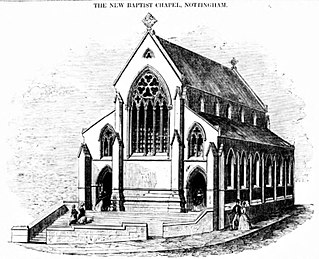Related Research Articles

Watson Fothergill was a British architect who designed over 100 unique buildings in Nottingham in the East Midlands of England, his influences were mainly from the Gothic Revival and Old English vernacular architecture styles.

Thomas Chambers Hine was an architect based in Nottingham.
Stanger is a surname. Notable people with the surname include:
Henry Isaac Stevens FRIBA was an architect based in Derby. He was born in London, in 1806, and died in 1873. In the late 1850s he changed his name to Isaac Henry Stevens.
Richard Charles Sutton was an architect based in Nottingham. He was born 1834 and died on 18 October 1915.
St. Paul's Church, George Street, was a Church of England church built as a chapel of ease to St. Mary's Church, Nottingham. It was opened in 1822 and closed in 1924.

Castle Gate Congregational Centre is in Nottingham. It is a Grade II listed building.

His Hon. Henry Yorke Stanger, was a British Liberal Party politician and judge.
Samuel Groves was a British organ builder based in London.

Captain Gilbert Smith Doughty CE was an architect based in Nottingham and Matlock.

Abraham Harrison Goodall LRIBA was a British architect based in Nottingham.

John Collyer was an architect based in Nottingham.

Francis Williamson was a British surveyor and architect based in Nottingham.

Ernest Richard Eckett Sutton FRIBA was an English architect based in Nottingham.

William Booker was an English architect based in Nottingham.

William Henry Booker FRHistS was an English architect based in Nottingham.
Henry Walter Wood was an English architect based in Nottingham.
Ernest Reginald Ridgway was an English architect based in Long Eaton.

Ernest Hooley LRIBA was an architect based in Long Eaton.
Thomas Wakefield (1791–1871) was an English industrialist and colliery owner, newspaper proprietor, and Whig local politician. He was twice mayor of Nottingham. Having suffered bankruptcy in 1848, he led an inconspicuous later life as an official.
References
- ↑ Guy's Hospital Reports. Guy's Hospital. 1840. p. 398.
- ↑ "Nottingham Dispensary" . Nottingham Review. England. 14 March 1845. Retrieved 16 February 2019– via British Newspaper Archive.
- ↑ "Medical Partnership" . Nottingham Review. England. 28 February 1845. Retrieved 16 February 2019– via British Newspaper Archive.
- ↑ "Partnerships dissolved" . Nottinghamshire Guardian. England. 22 March 1851. Retrieved 16 February 2019– via British Newspaper Archive.
- 1 2 UK Retail Price Index inflation figures are based on data from Clark, Gregory (2017). "The Annual RPI and Average Earnings for Britain, 1209 to Present (New Series)". MeasuringWorth. Retrieved 2 December 2021.
- ↑ "A Divorce Case. £3000 damages" . Louth and North Lincolnshire Advertiser. England. 16 March 1867. Retrieved 16 February 2019– via British Newspaper Archive.
- ↑ "Nottingham Bankruptcy Court" . Nottinghamshire Guardian. England. 3 January 1868. Retrieved 16 February 2019– via British Newspaper Archive.
- ↑ "Deaths" . Nottinghamshire Guardian. England. 14 May 1892. Retrieved 16 February 2019– via British Newspaper Archive.